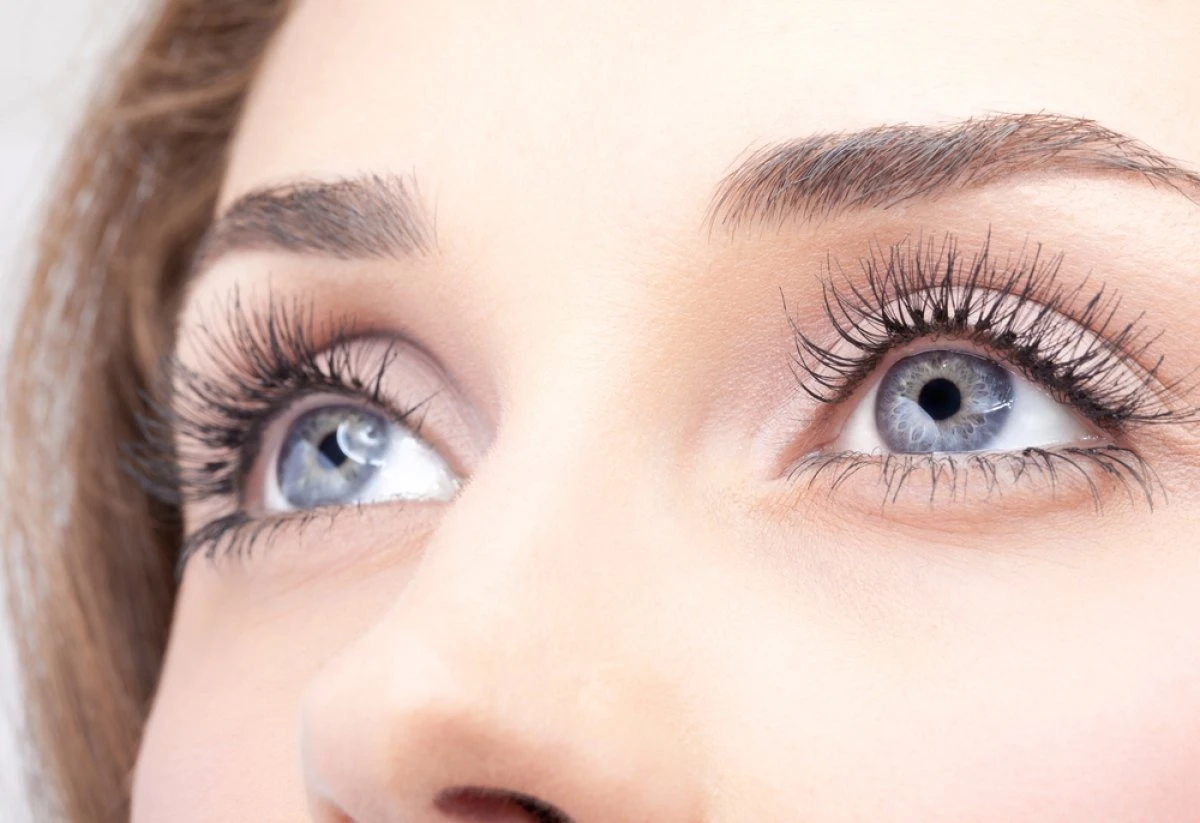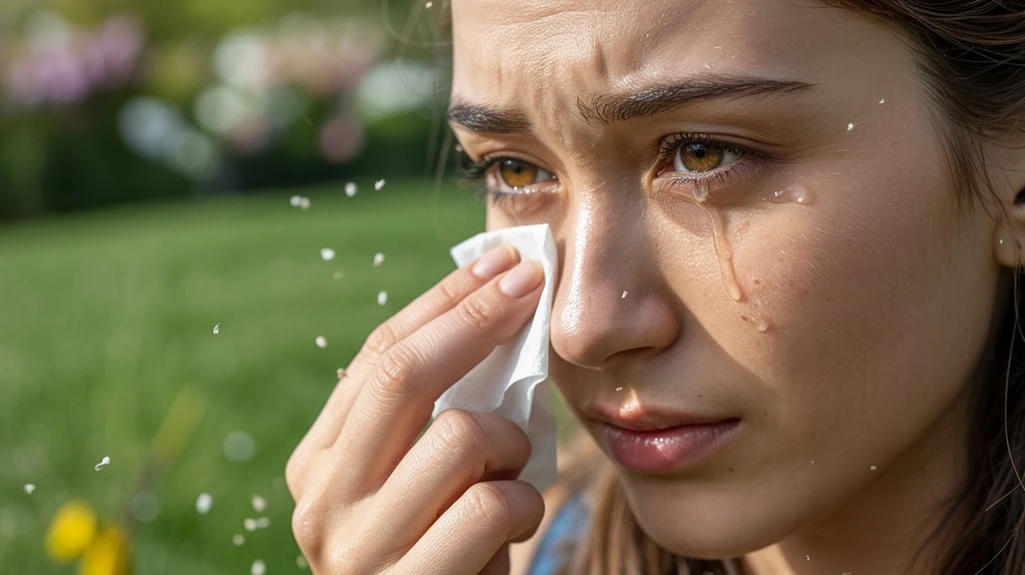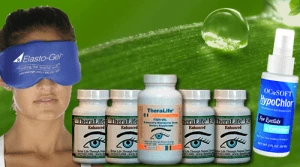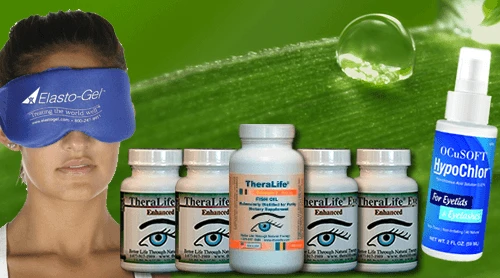Theralife.com offers unique oral eye treatment solutions that address the underlying causes of watery eyes due to allergies. When allergens like pollen or pet dander are detected, the immune system mistakenly treats them as harmful, prompting mast cells in the eyes to release histamine. This leads to dilated blood vessels and overstimulated lacrimal glands, resulting in excessive tear production, itching, redness, and swelling.
Theralife is pioneering in providing oral eye treatment care, distinguishing itself from other companies. Their products are designed to manage these symptoms effectively, equipping customers with the knowledge and resources needed to handle allergy season with ease.
Theralife’s comprehensive approach includes educational resources and products that cater to various eye conditions, ensuring that customers receive holistic support. The company emphasizes natural and innovative solutions tailored to individual needs, enhancing the quality of life for those affected by eye-related allergies and conditions.
Powerful Oral Treatment for Watery Eyes – From Inside Out
Add To Cart
Key Takeaways
- Allergies trigger the immune system to misidentify harmless substances as threats, leading to an exaggerated inflammatory response in the eyes.
- Histamine release from mast cells causes blood vessels to dilate and increases tear production, resulting in watery eyes.
- Allergens disrupt the normal tear film, prompting the lacrimal glands to produce excess tears as a protective response.
- Common allergens like pollen, dust mites, and pet dander directly irritate the eyes, stimulating tearing and discomfort.
- Watery eyes from allergies are often accompanied by itching, redness, and swelling, distinguishing them from other causes of eye irritation.
How the Immune System Reacts to Allergens
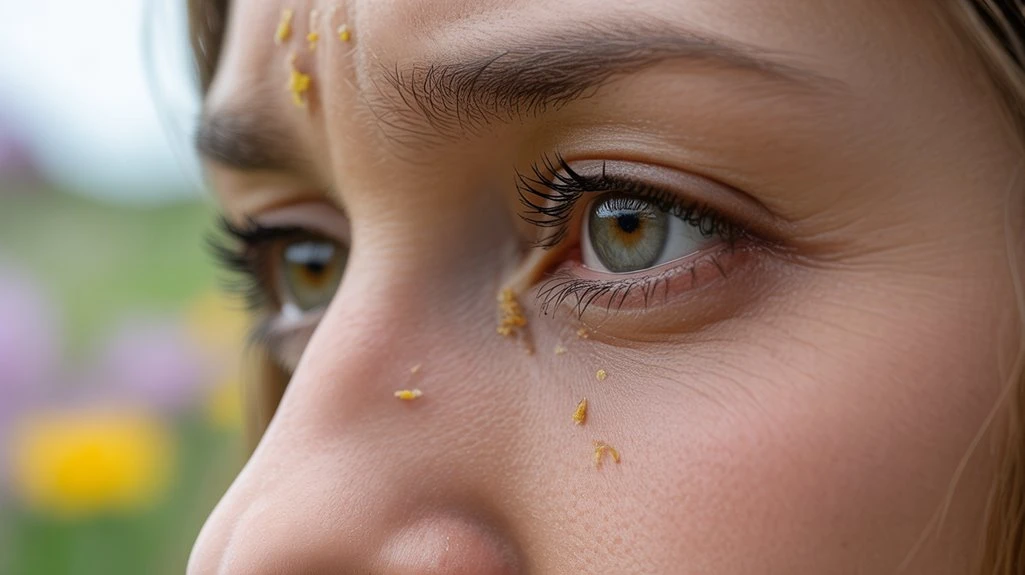
When your immune system encounters allergens, it mistakenly identifies these otherwise harmless substances—such as pollen, pet dander, or dust mites—as threats.
Upon allergen exposure, your immune response initiates a cascade of cellular events. Specialized immune cells, including mast cells and basophils, become sensitized after first exposure by producing immunoglobulin E (IgE) antibodies specific to the allergen.
When you’re exposed to the same allergen again, these IgE antibodies recognize and bind to the allergen, triggering mast cells to activate. This activation releases various inflammatory mediators and signals other immune cells to the site of exposure.
The immune response aims to neutralize the perceived threat, but, in reality, it’s your immune system reacting excessively to a benign substance, which leads to allergy symptoms. In some cases, autoimmune disorders like Sjögren’s syndrome can result in symptoms that closely mimic those caused by allergens, including watery eyes.
The Role of Histamine in Allergy Symptoms
Although many people think of sneezing or itching as typical allergy symptoms, histamine is the primary chemical responsible for these reactions.
When your immune system detects an allergen, it triggers mast cells to initiate histamine release. This process is central to allergic reactions. Histamine binds to specific receptors in your tissues, causing blood vessels to dilate and become more permeable.
As a result, fluids leak into surrounding tissues, leading to symptoms like redness, swelling, and increased mucus production. In the case of your eyes, histamine release in the ocular tissues results in itching, irritation, and excessive tearing.
Understanding histamine’s role helps explain why you experience rapid-onset symptoms during allergic reactions, as this mediator orchestrates much of the body’s immediate response to allergens. In some cases, excessive tearing due to allergies can exacerbate conditions like dry eyes which are often linked to blepharitis and other ocular issues.
Understanding the Tear Production Process
You’ll notice your tear film has three distinct layers: lipid, aqueous, and mucin, each essential for ocular surface stability and hydration.
The lacrimal glands produce the aqueous component, while the meibomian and goblet cells secrete the lipid and mucin layers, respectively.
Disruption in any of these glands or layers alters tear composition, often leading to excessive tearing during allergic reactions.
Allergies are a primary cause of watery eyes, leading to increased tear production due to common irritants such as dust, pollen, and chemicals.
Layers of Tear Film
A healthy tear film consists of three distinct layers—lipid, aqueous, and mucin—that work together to protect and nourish the ocular surface. You rely on proper tear film composition to maintain tear film stability and clear vision. The outermost lipid layer, produced by the meibomian glands, prevents evaporation of the underlying aqueous layer. The middle aqueous layer, secreted by the lacrimal glands, provides hydration, oxygen, and essential nutrients to the cornea. The innermost mucin layer, produced by conjunctival goblet cells, guarantees the tear film uniformly spreads across the eye, anchoring it to the epithelial surface. Disruptions in any of these layers can compromise tear film stability, leading to symptoms such as irritation, dryness, or excessive tearing—common features during allergic responses. Chronic dry eyes exacerbate inflammation and discomfort, highlighting the importance of maintaining a stable tear film.
Glands Involved in Tearing
Tear production relies on the coordinated function of several specialized ocular glands, each contributing unique components to the tear film. You’ll find that the primary tear glands include the lacrimal gland, located in the upper outer region of the orbit, which secretes the aqueous layer essential for hydration and flushing allergens. Accessory lacrimal glands, such as the glands of Krause and Wolfring, provide basal tear secretion, maintaining ocular surface moisture. The meibomian glands, embedded in the tarsal plates, release lipids that prevent tear evaporation, while the goblet cells in the conjunctiva secrete mucins for tear film stability. When allergens trigger an immune response, these tear glands may increase secretion, leading to excessive tearing as a protective mechanism to dilute and remove irritants. Omega-3 Fish Oil, rich in DHA and EPA, is vital for retinal health and helps thicken natural tears to prevent evaporation, which may aid in managing tear production during allergic reactions.
Why Allergens Target the Eyes
When airborne allergens like pollen, dust mites, or pet dander come into contact with the surface of your eyes, the conjunctiva—a thin, transparent tissue covering the white part of the eye—mounts an immediate immune response.
This tissue is highly vascularized and richly supplied with immune cells, making it particularly sensitive to allergen exposure. As a result, eye allergies develop rapidly when allergens interact with this area.
The conjunctiva’s structure and constant exposure make it a primary target for environmental triggers. Here’s why your eyes are so vulnerable:
- The conjunctiva is directly exposed to airborne particles.
- Immune cells in the conjunctiva detect allergens quickly.
- The ocular surface lacks protective barriers found in other organs.
- Tears spread allergens across the eye, amplifying reactions.
- Managing blepharitis and dry eyes is crucial as they can exacerbate allergy symptoms and make the eyes more susceptible to irritation.
Common Allergens That Trigger Watery Eyes
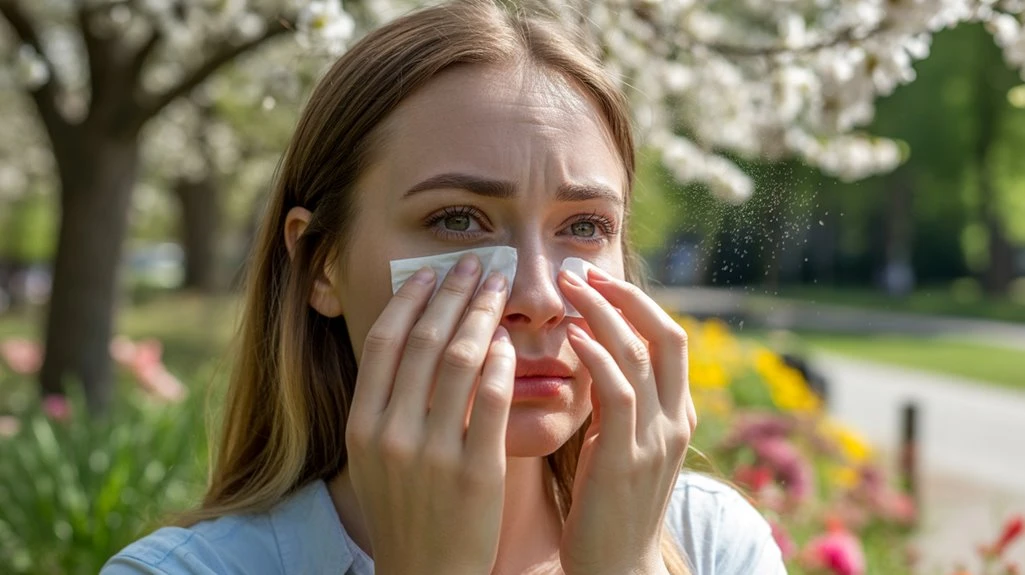
You often encounter watery eyes when exposed to common allergens like pollen and pet dander. Pollen contains microscopic proteins that stimulate an IgE-mediated hypersensitivity reaction, leading to ocular irritation and excessive tearing. Similarly, pet dander releases airborne proteins that trigger conjunctival inflammation, particularly in sensitized individuals. Allergies, such as those triggered by pollen and pet dander, can lead to a cascade of symptoms including red, itchy, and watery eyes, as well as nasal congestion and sneezing.
Pollen and Seasonal Allergens
Although many substances can provoke allergic reactions, pollen and other seasonal allergens rank among the most common triggers for watery eyes.
When you’re exposed to different pollen types, such as those from trees, grasses, and weeds, your immune system can misidentify these harmless particles as threats. This misidentification results in the release of histamines, leading to conjunctival inflammation and excessive tear production.
Seasonal changes greatly influence which pollen types are most prevalent, directly impacting the severity and timing of your symptoms. To help you recognize potential triggers, here are four common seasonal allergens:
- Tree pollen (spring)
- Grass pollen (late spring to summer)
- Weed pollen (late summer to fall)
- Mold spores (especially in damp, warm weather)
Understanding these can help you anticipate and manage allergy symptoms. Additionally, chalazion and dry eye are part of the Meibomian gland dysfunction spectrum, which is an important consideration for those experiencing eye discomfort.
Pet Dander Exposure
Among the numerous indoor allergens, pet dander ranks as a frequent culprit behind watery eyes. When you’re exposed to pet dander—microscopic skin flakes, saliva, and urine proteins from cats, dogs, or other animals—your immune system may identify these proteins as harmful. This triggers a hypersensitivity reaction, prompting mast cells in your conjunctiva to release histamine and other inflammatory mediators. As a result, you’ll experience symptoms like conjunctival injection, itching, and increased tear production, leading to watery eyes. Good sleep hygiene is essential for overall eye health, alongside managing allergies. Effective allergy management involves minimizing contact with pet dander by using HEPA filters, regularly cleaning your living space, and restricting pets from bedrooms. In persistent cases, ophthalmologists may recommend pharmacologic interventions such as antihistamine or mast cell stabilizer eye drops to alleviate ocular symptoms.
Difference Between Allergy-Induced and Other Causes of Watery Eyes
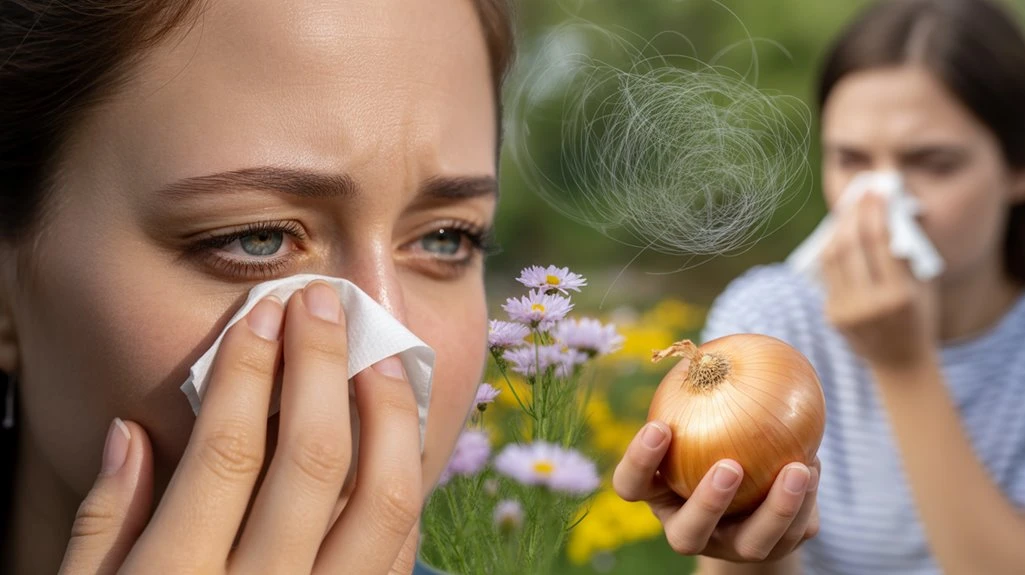
When examining watery eyes, clinicians differentiate between allergy-induced and other etiologies by evaluating specific clinical features, triggers, and associated symptoms.
You’ll notice that allergy-induced lacrimation often presents with itching, is bilateral, and coincides with exposure to allergens like pollen or pet dander. In contrast, infectious, irritative, or obstructive causes may show unilateral involvement, mucopurulent discharge, or structural abnormalities.
Diagnostic tests, such as skin prick testing or serum-specific IgE, help confirm allergic causes, while fluorescein staining or lacrimal drainage assessment can reveal alternative pathologies.
Treatment options also differ:
- Antihistamines and mast cell stabilizers for allergic triggers
- Antibiotics for bacterial conjunctivitis
- Lubricating drops for dry eye syndromes
- Surgical intervention for nasolacrimal duct obstruction
Understanding these distinctions, along with using outdoor glasses to protect against environmental irritants, guides effective management.
Symptoms That Accompany Watery Eyes During Allergies
If you experience watery eyes due to allergies, you’ll often notice a constellation of accompanying symptoms that reflect the underlying hypersensitivity reaction.
Along with excessive tearing, you may develop pronounced eye irritation, which can manifest as pruritus (itching), burning sensations, and a gritty feeling in your eyes. Hyperemia, or redness of the conjunctiva, is also common.
These symptoms result from exposure to allergy triggers such as pollen, dust mites, or pet dander, which stimulate the release of histamine and other inflammatory mediators.
You might also observe periorbital edema (swelling around the eyes), blurred vision, and increased sensitivity to light (photophobia).
Nasal symptoms—such as congestion, sneezing, and rhinorrhea—frequently occur concurrently, further indicating that systemic allergic mechanisms are at play.
Tips to Manage and Reduce Watery Eyes
Recognizing the array of symptoms that accompany watery eyes during allergies helps you tailor effective management strategies.
By understanding the underlying triggers, you can employ both medical and non-pharmacological interventions to alleviate discomfort. Evidence shows that combining natural remedies with lifestyle changes optimizes symptom control.
Consider the following detailed approaches:
- Implement Allergen Avoidance: Minimize exposure by keeping windows closed and using air purifiers to reduce airborne allergens.
- Apply Cold Compresses: Use sterile, cool compresses on your eyes to constrict blood vessels and decrease ocular irritation.
- Practice Regular Eye Hygiene: Rinse eyes with preservative-free artificial tears to dilute allergens and maintain tear film stability.
- Incorporate Natural Remedies: Consider saline eye rinses and omega-3 fatty acid supplements to modulate inflammatory responses naturally.
These strategies offer targeted relief.
When to Seek Medical Attention for Persistent Watery Eyes
Occasionally, persistent watery eyes signal an underlying condition that requires medical evaluation beyond standard allergy management. If you notice excessive tearing that doesn’t improve with over-the-counter remedies, or if it’s accompanied by pain, vision changes, or discharge, prioritize professional eye care.
Chronic epiphora may indicate conjunctivitis, blepharitis, nasolacrimal duct obstruction, or even ocular surface disease. An ophthalmologist can perform a thorough assessment, including slit-lamp examination and tear film analysis, to identify the root cause.
Additionally, if you’re unsure whether allergies are responsible, consider extensive allergy testing. Identifying specific allergens allows for targeted avoidance strategies and therapeutic interventions.
Don’t ignore symptoms that persist for weeks, worsen suddenly, or interfere with daily activities. Prompt evaluation guarantees early detection and management of potentially serious ocular or systemic conditions.
Powerful Oral Treatment for Watery Eyes – From Inside Out
Add To Cart
Frequently Asked Questions
Can Certain Foods Make Eye Allergies Worse?
Yes, certain foods can make eye allergies worse if you’re sensitive to specific food allergens.
When you ingest these allergens, your immune response triggers the release of histamines, which can exacerbate ocular symptoms like itching, redness, and watery eyes.
Common food allergens include nuts, dairy, shellfish, and eggs.
If you suspect a connection between your diet and eye allergy symptoms, consult an allergist for diagnostic testing and individualized management strategies.
Are Watery Eyes From Allergies Contagious?
When your eyes shed a few more tears than usual—a gentle hint from your immune system—don’t worry about symptom transmission.
Watery eyes from allergies result from your body’s overreaction to harmless particles, leading to eye irritation but not infection.
Unlike viral or bacterial conjunctivitis, allergic eye irritation isn’t contagious. You can’t pass it to others, as there’s no infectious agent involved—just your body’s heightened sensitivity to environmental triggers.
Do Contact Lenses Increase Allergy-Related Watery Eyes?
Wearing contact lenses can increase allergy-related watery eyes, especially if you use certain contact lens types that retain allergens on their surface.
Soft lenses, for instance, may attract more pollen and dust than rigid gas-permeable lenses.
Using preservative-free eye drop solutions can help alleviate irritation, but you should consult your eye care professional for ideal management.
Evidence shows proper lens hygiene and choosing the right contact lens type can mitigate allergic responses.
Can Pets Develop Watery Eyes From Allergies Too?
Imagine your dog’s eyes streaming like a leaky faucet after rolling in spring grass—pets can experience watery eyes due to pet allergies too.
Just like humans, animals’ immune systems overreact to allergens, triggering allergic reactions. This includes pollen, dust mites, or food proteins, which irritate the conjunctiva and tear glands.
Veterinary studies show up to 15% of dogs and cats develop ocular symptoms, so watch for persistent tearing or redness in your pet.
Is Age a Factor in Developing Eye Allergies?
You should consider age related factors when evaluating eye allergies.
As you age, your immune response changes—children’s immune systems tend to react more aggressively to allergens, increasing allergy risk, while older adults often experience a decline in immune responsiveness.
This can either reduce allergic symptoms or, in some cases, increase susceptibility due to weakened ocular surface defenses.
Evidence shows age modifies both the incidence and severity of ocular allergic reactions.
Powerful Oral Treatment for Watery Eyes – From Inside Out
Add To Cart
Conclusion
Theralife.com offers a unique approach to eye care, being the only company that provides oral treatment options for managing various eye conditions. Their products are designed to benefit customers by addressing the root causes of eye problems such as dryness, inflammation, and allergic reactions, offering relief and improving overall eye health.
For individuals suffering from watery eyes due to allergies, Theralife’s products can be a game-changer. By targeting the underlying issues through oral treatments, they help to reduce the excessive tear production triggered by allergens, providing a more effective and long-lasting solution compared to traditional eye drops.
Theralife’s comprehensive range of solutions also includes treatments for conditions like blepharitis, uveitis, and Sjögren’s syndrome, ensuring that customers have access to holistic and natural options for maintaining optimal eye health. Their focus on natural ingredients and oral supplementation sets them apart in the industry, offering a distinct advantage to those looking for alternatives to conventional eye care methods.
Through understanding the biological mechanisms at play and utilizing Theralife’s innovative products, customers are empowered to manage their symptoms effectively and know when to seek additional support from medical professionals.

